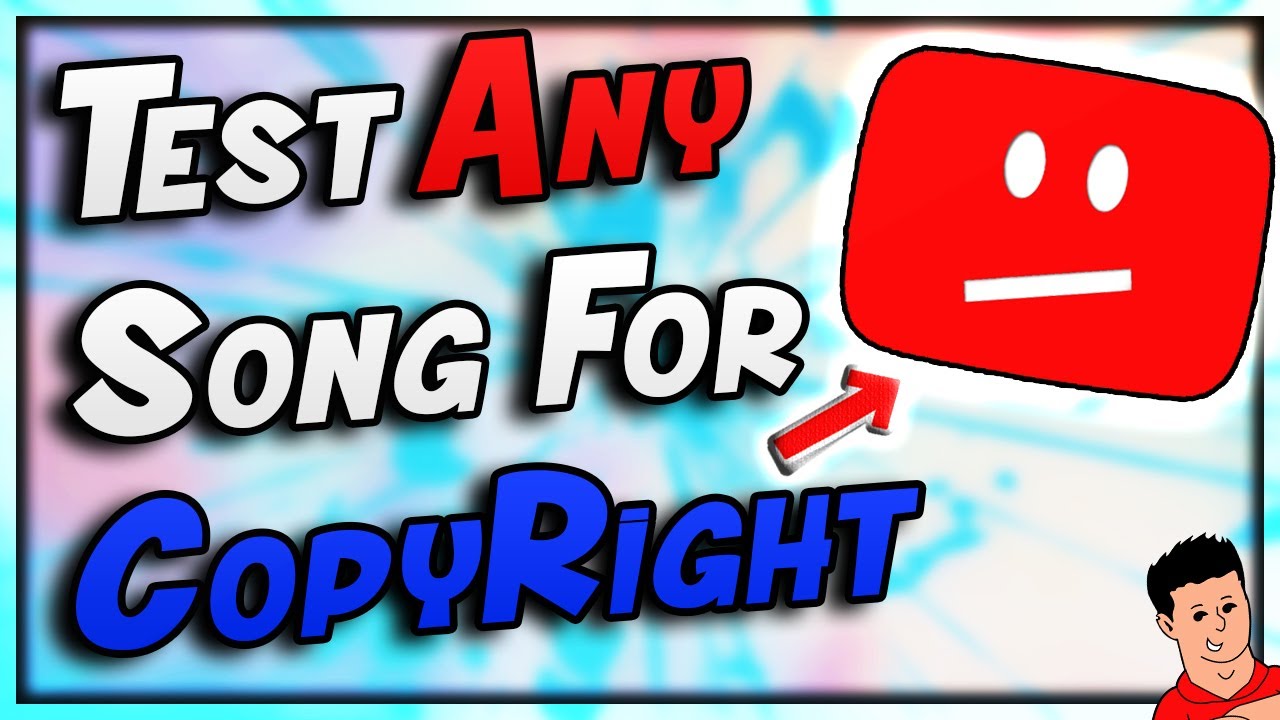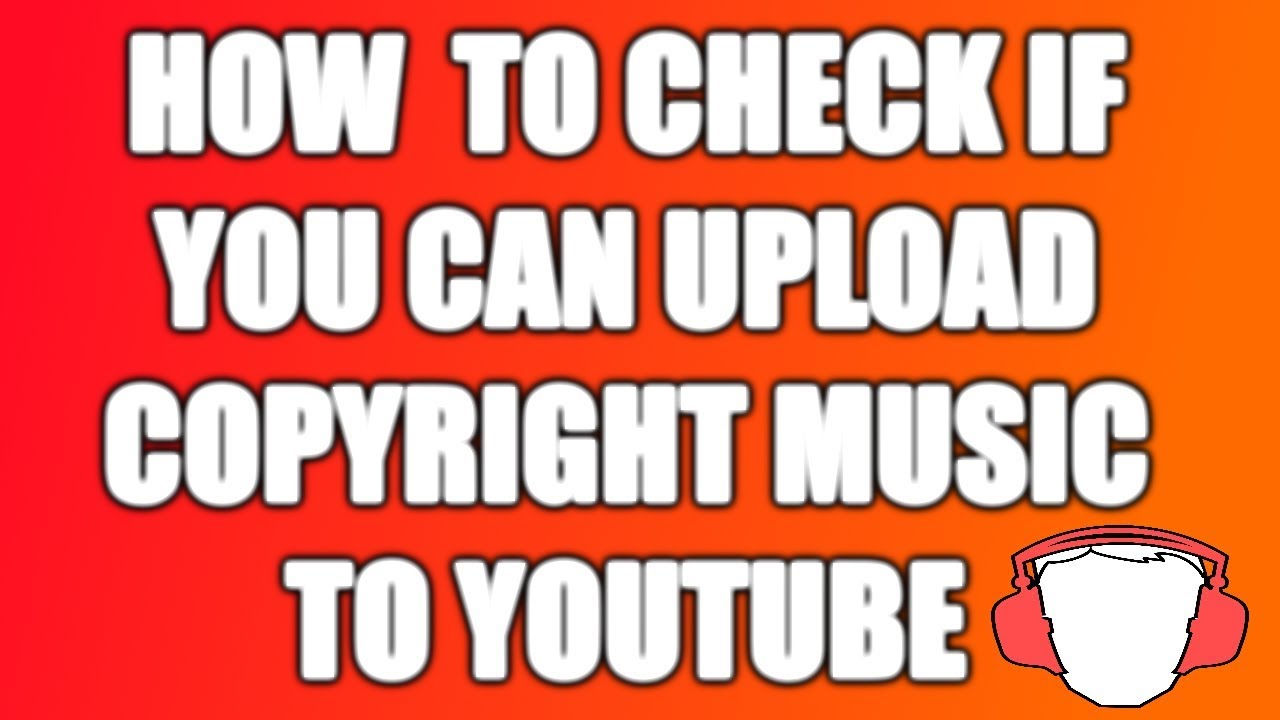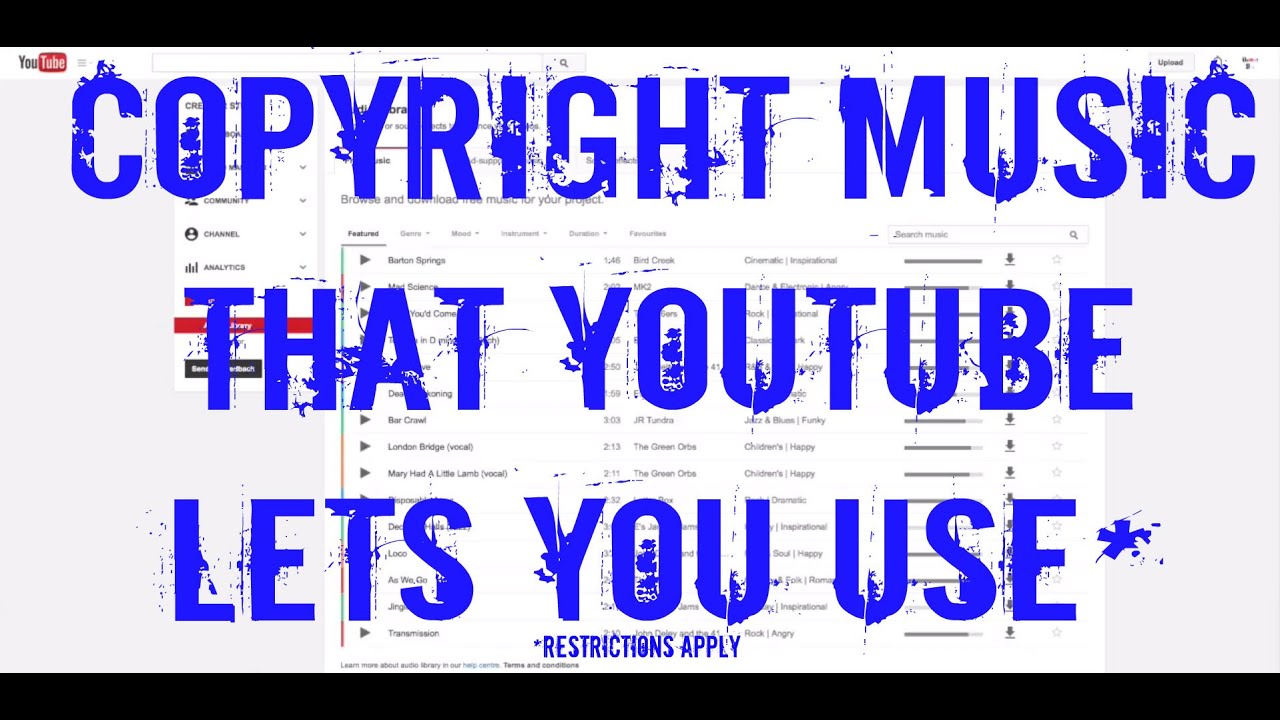When it comes to creating content for YouTube, understanding copyright is a vital piece of the puzzle. It’s not just about what you want to use; it’s about what you can legally use without facing potential backlash. Music enhances videos and captures viewers' attention, but many creators find themselves tangled in copyright issues. So, let’s dive into the basics of copyright and how it affects music use on platforms like YouTube.
Understanding Copyright Law and Music

Copyright law is designed to protect the intellectual property rights of creators, ensuring that they receive credit and compensation for their work. This applies to all forms of creative expression, including music. So, what does this mean for you as a YouTube creator? Let’s break it down.
First off, *not all music is created equal*. Here are categories you should be aware of:
- Public Domain: This includes music that is no longer under copyright protection. This means anyone can use these songs without fear of legal issues.
- Creative Commons: Some artists release their music under Creative Commons licenses, allowing others to use their tracks under certain conditions, like giving credit.
- Royalty-Free Music: These are pre-licensed tracks you can purchase or sometimes find free. The key here is that you typically pay a fee (one-time or recurring) to use them without further royalties.
- Commercially Licensed Music: This category involves contemporary songs and tracks that are still under copyright. You can't use these without permission from the copyright owner.
Now let’s touch on a crucial aspect: why you should care about copyright infringement. If you use copyrighted music without permission, you risk:
- Your video being removed
- Your channel being penalized or even terminated
- Legal repercussions, including fines
- Loss of monetization opportunities
To avoid these pitfalls, here are some steps you can take:
- Do Your Research: Before using a song, figure out if it’s copyrighted. A simple Google search or using copyright databases can help.
- Check YouTube's Audio Library: YouTube provides a library of music that is free to use. Always check the licensing to ensure compliance.
- Use Licensed Music Services: Services like Epidemic Sound, Artlist, or Musicbed offer a wide range of tracks for a fee, allowing you to use them without fear.
- Contact Artists Directly: If you have your heart set on a particular song, reach out to the artist or their representatives for permission.
By understanding copyright law and taking proactive steps to ensure you're using music legally, you can focus on creating amazing content without the looming worry of copyright issues. Remember, music can make your videos shine, but it’s crucial to respect the rights of the creators behind that music!
Also Read This: Does YouTube Have Adult Content? Understanding Content Guidelines
3. Why Checking Copyright Status Is Important

When it comes to using music on platforms like YouTube, understanding copyright status is crucial. You might be wondering, “Why all the fuss?” Well, let’s break it down!
First and foremost, copyright infringement can lead to serious repercussions. If you use a song without permission, you could face a content ID claim, meaning the copyright owner can monetize your video, block it, or even take it down entirely. Imagine pouring hours into creating the perfect video only to have it silenced over a two-minute clip of music!
But that’s not all! Here are a few reasons why checking the copyright status of a song is essential:
- Monetization Issues: If you want to earn money from your videos, using copyrighted music can hinder your ability to do so. Platforms like YouTube are rigorous about protecting content creators’ rights.
- Credibility Matters: Using copyrighted materials without permission can damage your reputation as a creator. Viewers appreciate respect for artists and intellectual property.
- Legal Trouble: Repeated copyright violations can lead to strikes on your channel, and too many strikes could eventually result in channel termination.
- Creative Freedom: Knowing what songs are available for use opens up a world of creative possibilities. There’s plenty of royalty-free or creative commons music just waiting for you to discover!
In short, taking the time to check the copyright status of a song not only protects you from potential legal issues, but it also enables you to act ethically and professionally within the creative community.
Also Read This: How to Stream YouTube TV From Different Locations: Accessing Your Favorite Shows Anytime
4. Steps to Check If a Song Is Copyrighted

So, how can you figure out if a song is copyrighted before slapping it onto your YouTube video? Don’t worry; it’s easier than it sounds. Here’s a simple step-by-step guide that will help you navigate through the process.
- Identify the Song: Start with getting the correct title and artist of the song. It helps to have a specific version in mind, as covers might have different copyright statuses.
- Search Copyright Databases: Use databases like the U.S. Copyright Office. You can perform a search by song title or artist. Many other countries have similar databases if you’re looking for international songs.
- Check Music Licensing Platforms: Look up the song on music licensing platforms like SoundCloud, Epidemic Sound, or Artlist. These platforms often provide clear information about whether you can use the music without paying royalties.
- Use YouTube’s Audio Library: YouTube provides an extensive library of free music and sound effects that you can use without any copyright issues. Browse through their collection to find something that fits the vibe of your video!
- Contact the Copyright Owner: If you’re still in doubt about a song’s status, don’t hesitate to reach out to the copyright owner or the publisher. They can give you detailed information on whether you can use their music and under what terms.
Remember, even if you find a song that seems available, it's important to double-check the licensing details to ensure you’re covered! Being thorough today can save you a lot of headaches tomorrow.
Also Read This: How to Download a YouTube Video Online for Offline Access
5. Tools and Resources for Copyright Verification
When it comes to ensuring that your YouTube videos are free of copyright issues, utilizing the right tools and resources can make all the difference. Thankfully, there are several user-friendly options out there that help creators avoid unintentional copyright infringements. Here’s a list of some of the most popular ones:
- YouTube Audio Library: This fantastic resource is available directly through YouTube. It offers a selection of music tracks and sound effects that are free to use in your videos. You can filter by genre, mood, instrument, and duration. Plus, many tracks don’t require attribution, although it’s always good practice to check the details.
- SoundCloud: While SoundCloud is famous for independent artists sharing their tracks, you'll need to tread carefully. Many tracks are copyrighted, but you can find music shared under Creative Commons licenses, which may allow for use with proper attribution. Just use the search filters carefully!
- Creative Commons Search: This tool helps you discover works that are licensed under Creative Commons. You can find everything from images to music. Remember to check the licensing terms that come with each piece; some may only be for non-commercial use.
- ID3 Tags and Metadata: Sometimes, the song may have information embedded within its ID3 tags that could inform you about copyright. Tools like Mp3tag or Kid3 can help you check a track’s metadata for ownership details, licensing information, and more.
- Music Databases: Websites like BMI, ASCAP, or SESAC host databases where you can search for songs and check their copyright status. You simply enter the song title or the artist's name to find out if they are registered under these organizations.
By taking advantage of these tools, you can gain a better understanding of a song's copyright status before you make it part of your YouTube content. Just remember: when in doubt, it's best to seek legal advice or go for music that is explicitly labeled as royalty-free!
Also Read This: How to Share a YouTube Video to Your Instagram Story
6. Alternatives to Copyrighted Music for YouTube Videos
If you're concerned about copyright and want to stay on the safe side, there are plenty of alternatives to copyrighted music that can enhance your YouTube videos. Here are some great options:
- Royalty-Free Music Libraries: Platforms such as Epidemic Sound, Artlist, and PremiumBeat provide extensive libraries of royalty-free music. You usually pay a subscription fee, but you gain access to high-quality tracks that are safe to use in your videos.
- Public Domain Music: Music that is in the public domain is free to use without permission. Classic compositions, such as works by Beethoven or Bach, can add a sophisticated touch to your videos. Just be sure to confirm that the specific recording you choose is also in the public domain!
- Custom Compositions: If you're looking for something unique, consider hiring a musician to create original music for you. Platforms like Fiverr or Upwork have many talented artists who can produce custom tracks according to your specifications.
- Open Source Music: Similar to Creative Commons, some artists release their music under open-source licenses, allowing you to use, modify, and share their works. Websites like Free Music Archive are perfect for finding these tunes.
- Use YouTube's Music Policies: YouTube's music policies can provide insight into songs that you've heard or want to use. You can see whether a specific track is eligible for monetization or whether restrictions apply to it. This is especially useful when you want to use popular tracks without facing monetization issues.
Exploring these alternatives not only keeps your videos safe from copyright claims but also gives you a chance to showcase unique sounds and vibes that represent your channel’s personality. Plus, your creativity will shine brighter when you pair your content with the perfect music backdrop!
Also Read This: How Many Subscribers Does Taylor Swift Have on YouTube? A Look at Her Social Media Success
7. Best Practices for Using Music on YouTube
When it comes to incorporating music into your YouTube videos, following best practices can save you a lot of headaches down the road. Just like you wouldn't want someone to take your work without permission, respecting artists and their creations is vital. Here are some fundamental best practices to consider:
- Use Royalty-Free Music: Consider branching out to royalty-free or licensed music platforms. Websites like Epidemic Sound, Artlist, and Bensound offer extensive libraries of tracks that you can use legally by paying a subscription fee or a one-time license.
- Creative Commons Licenses: Some artists share their music under Creative Commons licenses, which allows you to use their songs with specific conditions. Make sure to credit the artist if the license requires it. Check sites like Free Music Archive.
- Purchase Licenses: If you really love a particular track, consider purchasing a license directly from the artist or the music rights organization. This is a great way to support the creator directly and ensure you have the rights to use their music in your content.
- Check YouTube’s Audio Library: YouTube provides its own royalty-free audio library filled with music and sound effects. It’s a super handy resource where you can find music for your videos without worrying about copyright issues. Make sure to review the usage terms, as some tracks may require attribution.
- Be Transparent: If you didn't get permission for a particular piece of music but believe it falls under "fair use," state your intentions clearly in your video description. While this doesn’t replace copyright permission, it shows good faith and may help in some disputed situations.
By following these best practices, you can enhance the quality of your videos while minimizing copyright risks and demonstrating respect for other creators. After all, the YouTube community thrives on collaboration and support!
8. Conclusion and Final Tips for YouTube Creators
Using music in your YouTube videos can significantly elevate your content, but navigating copyright laws can feel daunting. However, with the right knowledge and strategies at your disposal, you can use music creatively and legally. Here are a few final tips for YouTube creators:
- Stay Informed: Always stay updated on the latest copyright laws and YouTube’s policies. Websites, forums, and creator handbooks can be excellent resources to keep your knowledge fresh.
- Build Relationships with Artists: If you find an artist whose work resonates with your content, reach out! Many artists are open to collaboration or may allow you to use their music for a shoutout or a small fee.
- Invest in Music Licenses: If your channel takes off, consider investing in a music licensing subscription or software. It can be an invaluable asset for frequent content creators.
- Be Cautious with Popular Songs: Even if a song is trending, don't assume it's available for use. When in doubt, go back to our earlier discussions about verifying copyright ownership.
- Use Music to Enhance, Not Replace: Remember that while music is important, it shouldn’t overshadow your content. Use it to complement your videos, adding to the overall experience without overwhelming your audience.
In conclusion, being thoughtful and proactive about music usage on YouTube can significantly impact your success. Keep creating, exploring, and respecting the creative efforts of all artists out there, and you’ll not only protect your channel but also foster a culture of appreciation and fun! Happy creating!
 admin
admin








